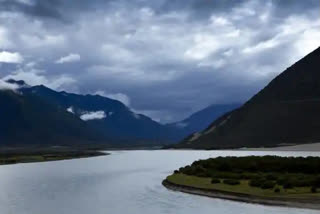Hyderabad: Though comprising of 18 per cent of the global population, India occupies only two per cent of the World's land and enjoys command over only four per cent of the earth's water resources. Yet, it is not even able to avail two-thirds of its river water resources. Unification of rivers is one of the considered means for a more efficient utilisation of river waters.
Lack of unity, mutual goodwill and nationalistic spirit is at the root of the failure of states to come together for river inter-linking. This tendency is causing states to frequently suffer either floods or famines. During the proceedings of Kaveri water dispute resolution earlier, the Supreme Court had stated that river waters are a national resource.
The fact is… united action for river water utilisation remains a mirage. This was also corroborated by the National Water Development Agency (NWDA) which held webinars on various related topics for three and half months recently. The agency has drawn the conclusion that refusal by states to confirm availability of surplus waters with them, divergent stands between neighbouring states and narrow-minded considerations at all levels are proving to be major challenges to the unification of rivers. When it comes to the unification of rivers, the moot question remains as to how to avoid conflicts that could lead to problematic situations after the diversion of river waters.
The Central government had announced in March last that a separate executive mechanism will be brought into force for the interlinking of rivers. But the mechanism still remains only on papers. NWDA believes that if a committee of legal luminaries is established to remove the stumbling blocks to the river interlinking, the need to enact new laws for the purpose may not arise. The agency has also recommended creation of a River Unification Authority along with the formulation of a national water policy. It is important that the Centre implements these recommendations forthwith. It is equally important that proper understanding is promoted among states for this purpose.
Read:Uttarakhand tragedy triggers memories of 2013 floods
The idea of river water sharing by interlinking surplus water river basins with deficit river basins was first visualised by Dr KL Rao way back in 1972. He had proposed Ganga-Kaveri link canal which, it was visualised, would provide a flood flow of 60,000 cusecs near Patna for 150 days in a year. According to Dr Rao's vision, this flood water would help irrigate 40 lakh hectares of land. However, the vision was never realised.
During Atal Bihari Vajpayee's Prime Ministerial stint, a committee was constituted under the leadership of Suresh Prabhu to study inter-linking of rivers. The committee had come to the conclusion that with the unification of rivers the extent of irrigated land in the country would increase to 16 crore hectares. It would also help generate 34 Gigawatts of power, the committee estimated.
According to the original plan, the costs involved in river interlinking was to be shared by the Centre and states at a ratio of 60:40. Last year, the cost-sharing ratio was altered to 90:10. It was also widely publicised that the Jalshakti Ministry of the Central government will review the 47 inter-state irrigation project proposals from nine States. In a sensational development on the other hand, the governments of Madhya Pradesh, Karnataka, Odisha and other states have written letters to the Centre registering their opposition to the proposed river interlinking.
Read:J&K: Thajiwas glacier in Sonmarg receded 50 meters in 3 years, experts warn of danger
Official statistics state that as against the availability of 1.87 lakh crore cubic meters of river waters, the country is able to utilise only 1.12 lakh crore cubic meters. This clearly reveals the wasteful flow of a huge quantity of precious, nature-given river waters into the ocean. The laxity towards the maximum utilisation of river water sources is leading to an ironic situation where some states are facing floods while others are suffering droughts at the same time.
This is not only causing extensive loss of life and property, but is also hampering agricultural and industrial development. Interlinking of rivers could lead to multiple benefits to the country. Delay in the efforts to give effect to it could be highly detrimental. Irrigated agriculture will prosper in the country only if states shed their narrow considerations and make a united move towards unification of rivers.
